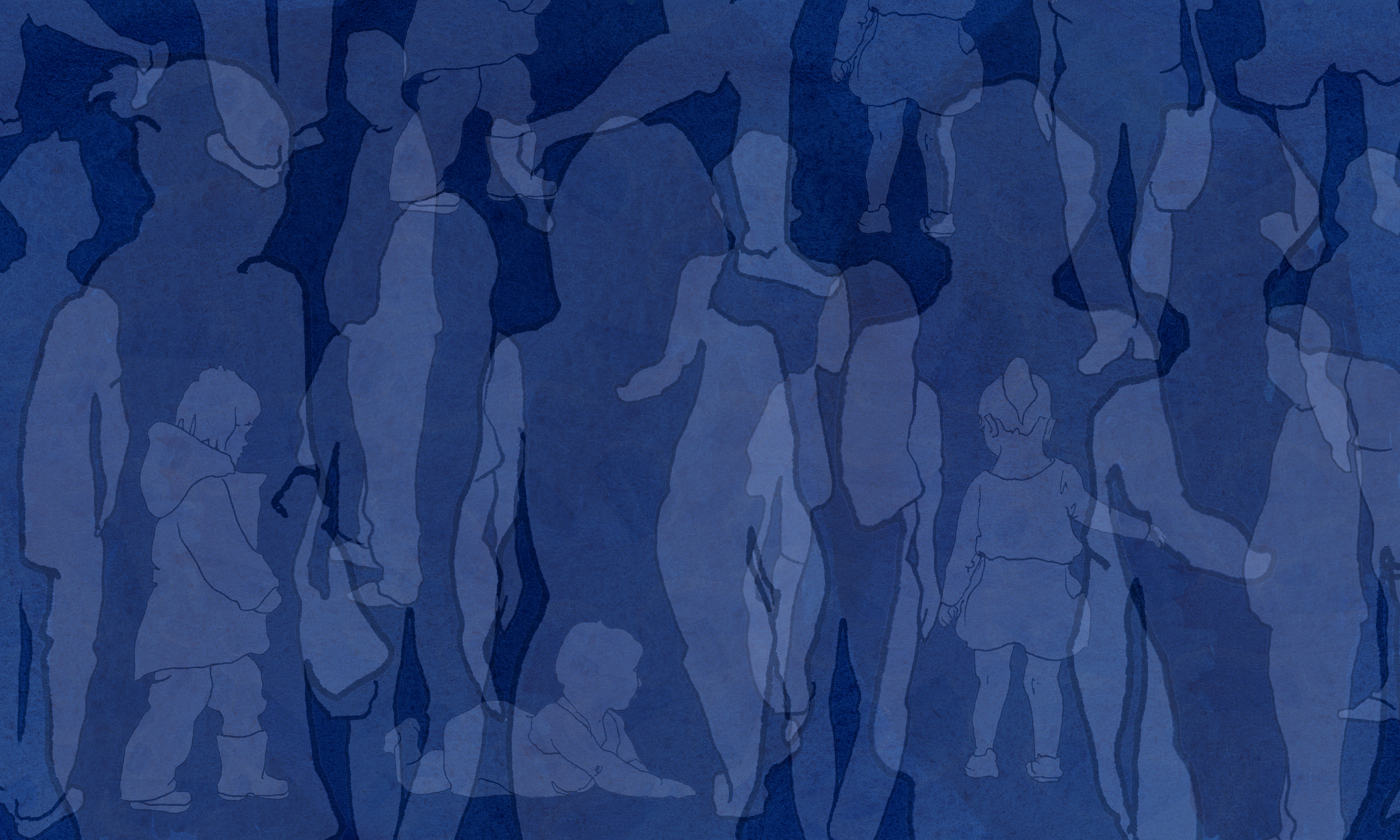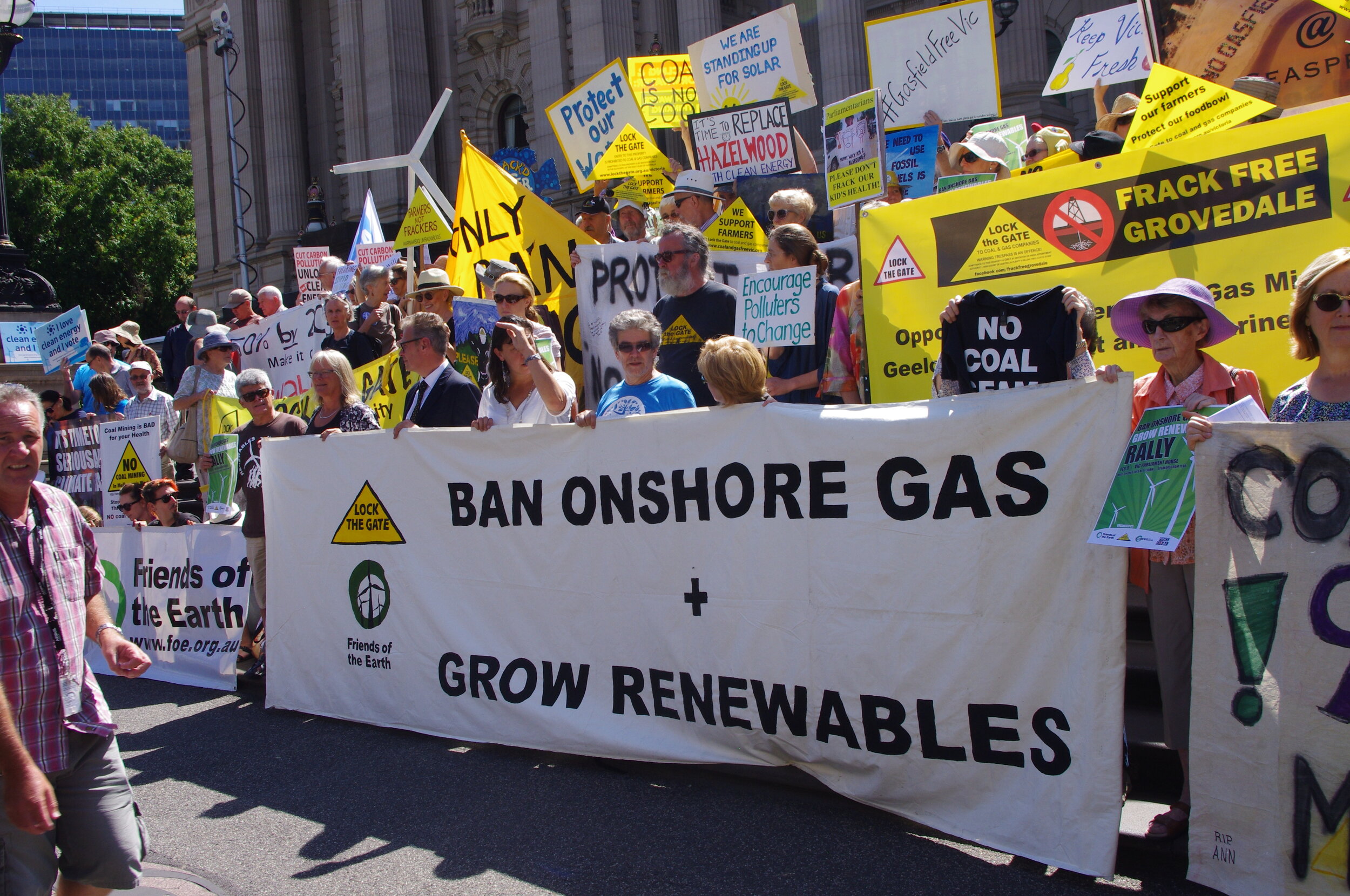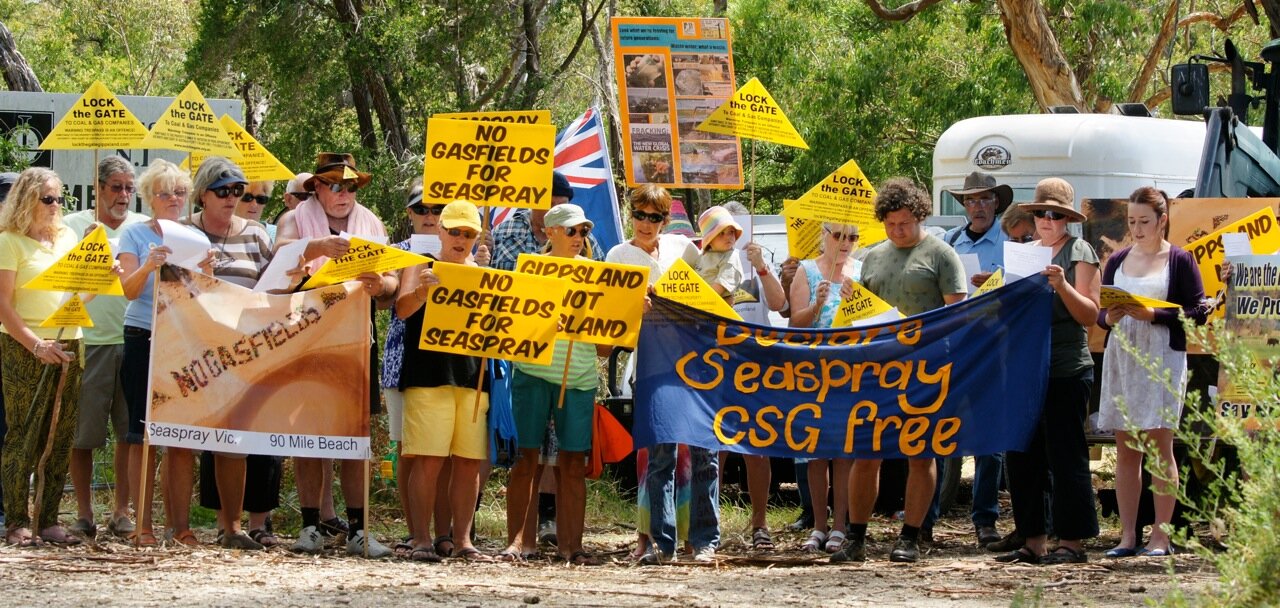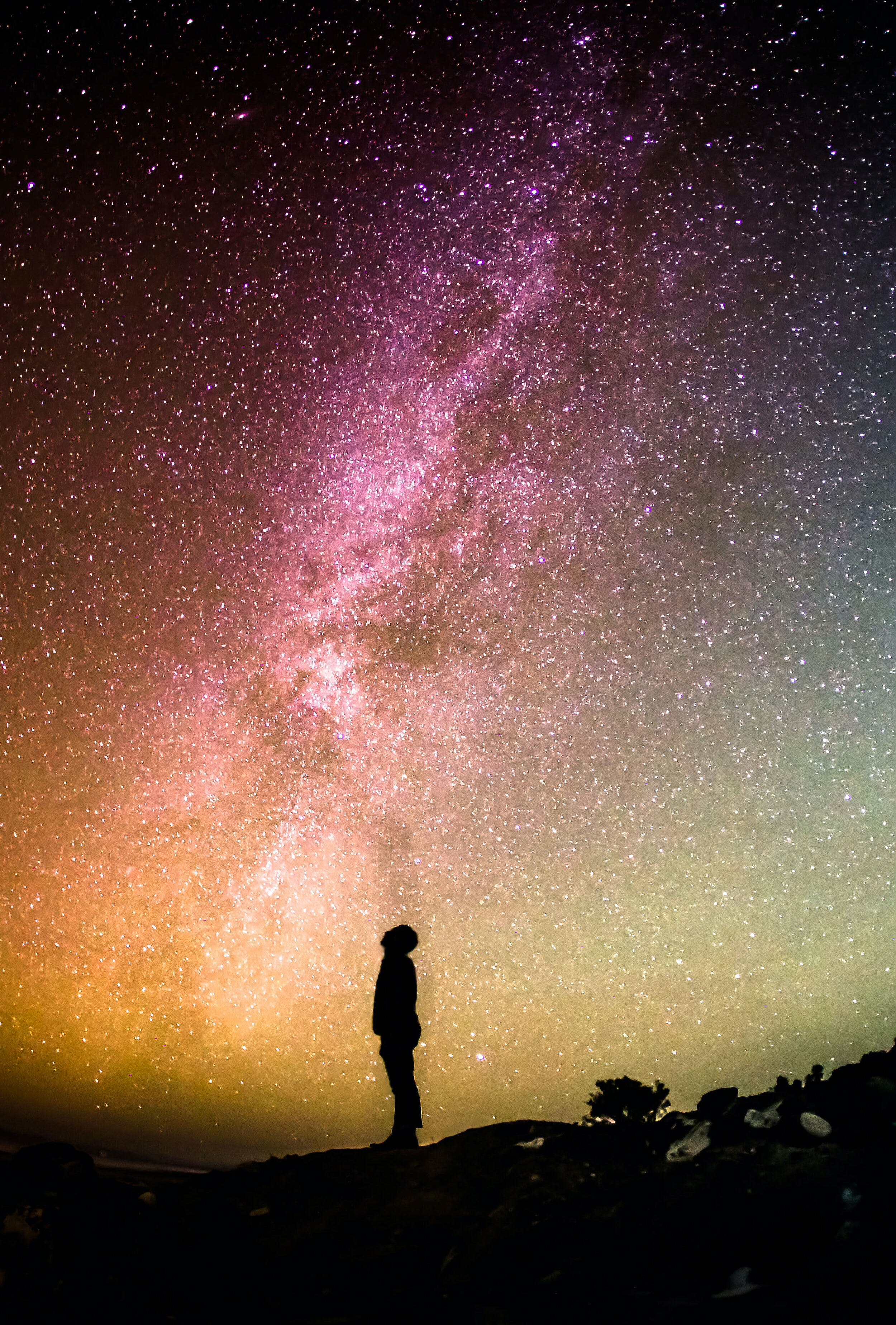‘Always look up’: connecting community for a win against gas
The Seaspray Community’s striking beach campaign (Photo: Friends of the Earth)
Taking the campaign to the city (Photo: Friends of the Earth)
Goosebumps. They’re one of my favourite parts of this job. The moment when I’m chatting to some inspiring person and they tell me a small anecdote that brings to life the beauty and the humanness of the work that they do, and we both either weep or start talking loudly and excitedly.
Recently I had the pleasure of chatting with Cam Walker, Campaigns Coordinator, at the non-profit environmental advocacy organisation Friends of the Earth (FoE). I knew that FoE had played an important role in winning a constitutional ban on fracking in Victoria and that people were talking about it as an inspiring win for community. Of course I wanted to know more!
Cam told me about horses being ridden through the Melbourne CBD, thousands of sheep being shepherded to spell out “Ban Gas”. I heard about love of land and a willingness to work across difference. But before we get to the goosebump stories, it’s worth understanding a little bit more about the nuts and bolts of the campaign.
Firstly it’s important to know why a constitutional ban on fracking is something worth celebrating. Fracking is the process used to extract coal seam and other forms of ‘unconventional’ gas from the ground that has significant health and environmental impacts both globally (climate change) and locally (polluted air and water, loss of good farmland, poor health outcomes for workers etc).
You can read the detail of how things unfolded on the FoE website campaign diary but it went something like this:
FoE helped to establish Lock the Gate in Queensland as a part of their work supporting communities pushing back against the emerging fracking industry.
Thinking about this experience and its relevance to Victoria, Cam and the FoE crew recognised that there were a large number of coal seam gas licences, and new coal mine proposals in Victoria and that there was a real risk to people and environment if communities didn’t come together to ban fracking.
FoE organised community meetings in relevant areas and brought in people from other communities who had experienced the negative impacts of fracking.
Interested community members would then hold kitchen table conversations (a process of gathering people for open conversations about an issue) and determine what actions to take (FoE supported these groups as needed). 75 community ‘coal and gasfield free’ groups were established across the state.
Following the Lock the Gate model, local anti-fracking groups doorknocked their entire communities seeking people’s opinions on going coal and/or gas free (every community had at least 80% of residents wanting gas free communities), and would then hold an event and public declaration of intent to be gas free.
At the same time FoE facilitated community engagement with political staffers and ministers and supported communities to understand democratic processes and how to campaign effectively to win campaigns. The data collected by groups proved invaluable to convincing politicians of community sentiment.
This was not a short campaign. In fact it took a decade for the Victorian Government to finally commit to a constitutional ban on fracking. So how did the campaigns maintain momentum? And what were some of the key elements that made the campaign so successful?
Seaspray Campaign (Photo: Friends of the Earth)
‘We are stronger together’
Cam attended public meetings all over rural Victoria where FoE and other groups (such as Doctors for the Environment and the Environment Defenders Office -- now known as Environmental Justice Australia), would present information about the potential risks of fracking to the area. Someone with personal experiences of the negative impact of coal seam gas and other drilling were also often at the meetings, sharing their stories. The initial meeting would end with an invitation to get involved in starting a local group to oppose drilling. A key message was always that there was room for everyone in the movement: “If you are worried about any element of this, then you belong here. YOU belong.” It didn’t matter if people were concerned about heavy vehicles in the streets, contaminated water tables, landscape amenity, climate impacts, or anything else, if fracking concerned them, they were welcome. They were told that each person carried their own thread of concern, but when woven together they could form a strong thick rope.
Politics was to be left at the door.
To form an alliance with local communities, FoE had to build connection and trust. Often at the first meeting there’d be a line of blokes at the back with their arms crossed. As Cam explained, farmers are used to being strong and just ‘sticking it out’. They weren’t sure about these ‘greenies’. Yet as Cam said, “After a couple of meetings they’d tell you over a cuppa in the kitchenette how much they loved their farm and this land and the country they were on.”
One later told him, “when you first said we could win, it sounded like a fairy tale. I didn’t believe you. But I wanted to believe you.”
Together they have proven that history can be written by communities.
Community meeting (Photo: Friends of the Earth)
Let go of power
After the main public meetings facilitated by FoE, communities were encouraged to run kitchen table conversations to build connections and work out what to do next. Kitchen table conversations are community conversations held in informal contexts with the basic rule that everyone gets a say and everyone listens respectfully. This process has been used by many different groups but is perhaps best known for the role it played in the Voices 4 Indi campaign to elect Independent Cathy McGowan in 2013, and then Helen Haines in 2019 (we’ve written about this in another blog).
The kitchen table conversations proved key in enabling different members of the community to come together, share ideas, build trust and focus on their shared concerns. At this point FoE would give up control, supporting groups as needed but letting local communities do things their own way. Cam was passionate about community control saying that it is important to “never fear power being let go” and handed over to those being impacted. It was up to these local groups to decide how to engage, the stories to tell, and the forms that protest and celebration would take. It meant trusting each other to be able to speak about the issue publicly in ways that were personal and relevant.
Of course, having alerted communities to the problems, FoE didn’t then just disappear; they hovered on the fringes offering support where it was needed. Groups could turn to FoE for media training, connections to experts, the database technology for managing members and other training opportunities. All of this was offered freely. Local groups maintained their own control of not only their mailing lists but how they ran their campaigns.
Photo: Greg Rakozy (Unsplash)
‘Always look up’
While Cam was clear that FoE did not control the community groups, it was obvious to me that they played a really important facilitation role: connecting individuals with each other, communities with communities, and communities with government and bureaucracy. And perhaps even more importantly, they helped to establish the culture of the movement. Not only did they clarify up front that everyone was welcome, they also emphasised that to win individuals and communities would have to “always look up”. Cam explained that the plan was to organise locally but ‘always look up’; connecting local action with the power of the state structure and remembering that it wasn’t just about one small area winning at the expense of another community.
There couldn’t be any sense of shifting the burden to another community: to win would mean to win together.
A deep level of solidarity between communities was a cornerstone of the campaign from the very start. This wasn’t a ‘NIMBY’ campaign: it was a mutual effort to stop an invasive industry from getting established across all of regional Victoria.
Embrace love of place
There is a skill of course in working together and collaborating and remaining true to your own people and place. As each community declared itself gas free, they did so in ways that made sense locally. The township of Poowong – first to declare – made a human sign on their sports oval. Seaspray in South Gippsland spelt out a massive sign on the 90 Mile Beach. Other communities declared themselves coal and gas free communities with celebration days complete with local preserves and jams, music, and media centres run out of horse floats!
As the campaign dragged on, there was the endless need to keep the pressure on the politicians and in the media. This meant lots of actions and public events.
Farmers take action with their sheep (Photo: Friends of the Earth)
Perhaps the best known of these was the community of farmers who gathered 2,000 sheep and used them to write ‘ban gas’ in a paddock, which was filmed via drone. This was such a successful stunt that there was concern that the campaign had hit “peak sheep” and that there was nothing left to do!
That people could be themselves in the way they campaigned and celebrated seems key to success and fits closely with what we’re finding in our public good conversations: people want to contribute, they want to matter and they want to belong to their own community in their own ways.
Maintaining motivation over the long haul
I asked Cam about how people maintained enthusiasm and energy. He said that was a challenge; the campaign went for almost a decade. They had wins to buoy them but they also had set-backs which were challenging and de-motivating. The key however was the organising and the connection. While it was hard to find things to do after “peak sheep”, FoE recognised that people were a part of the campaign not just to stop unconventional gas, but because it was a way to belong to community and to connect across other differences or potential divisions. They’d find ways to keep community connections going in ways that were social (like public events and picnics) but also meaningful (like gathering to think about who hadn’t yet been listened to in the community). The strong sense of collaboration, fun and connection to place, held the decade-long thread.
Community connection is an infrastructure for future joy
Seaspray celebrations (Photo: Friends of the Earth)
The community thread, now woven into a strong rope, continues beyond the success of the anti-fracking campaign. Some groups have gone on to push for wind farms, a fairly radical turn around given many communities initially had strong feelings against such technology. Other groups have begun working on projects to create sustainable futures, while others are using their organising and advocacy skills to push back against other undesirable developments (such as the Mine Free Glenaladale campaign against the Kalbar Minerals sand mine).
Listening to Cam I’m struck by his calm kindness and his deep belief in the importance of doing this urgent environmental work slowly. He talks about taking the time to find common ground, to build networks of community trust and how toxic evangelising on any issue can be. This anti-fracking campaign had multiple positive outcomes. Not only did it end with a constitutionally enshrined ban on fracking in Victoria, but it continues with strong, engaged and connected communities.
I can’t help but think that we need to get better at listening out for these types of stories – stories that show us not only what is possible to achieve for the future, but model for us a process that in itself creates a kind and connected present. And I am so extremely grateful for the courage and tenacity these communities showed in moving us one step closer to being a country where people and planet are prioritised over profit.
DR MILLIE ROONEY
Millie is the National Coordinator for Australia reMADE. Millie has a qualitative research background and has spoken in-depth with hundreds of Australian's about their lives, communities and dreams. She has worked in and around universities for over a decade building student capacity and enthusiasm for tackling wicked problems. Millie is also a carer for her family and community and is passionate about acknowledging this work as a valid, valuable and legitimate use of her time.
Other blogs by millie: From trepidation to transformation: democracy, indi- style
Forget GDP, we need a bold new ‘why’ fit for the times we live in’
One way to take the helm










